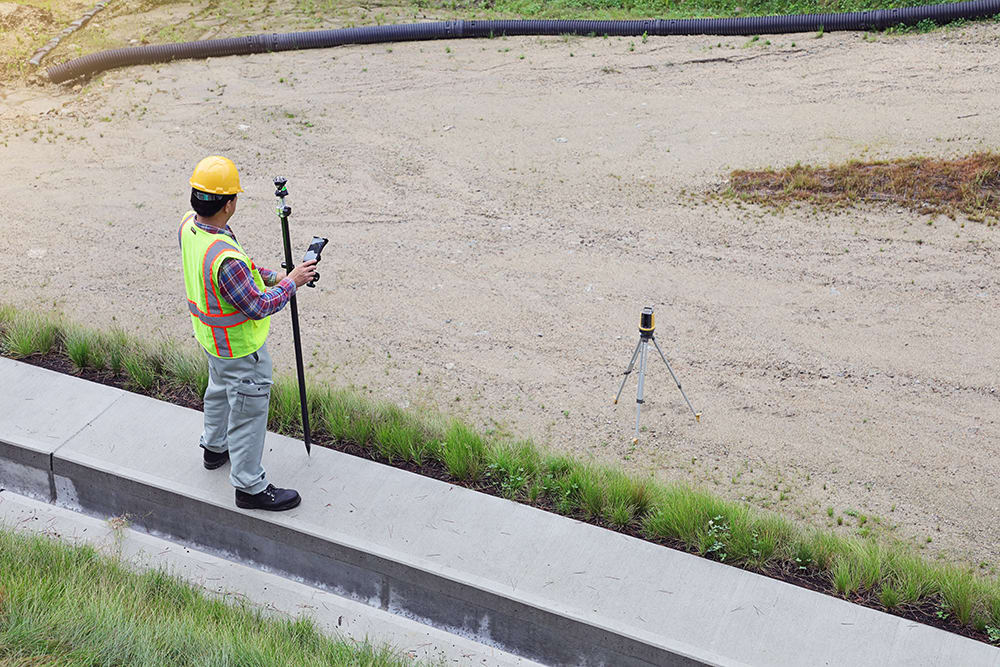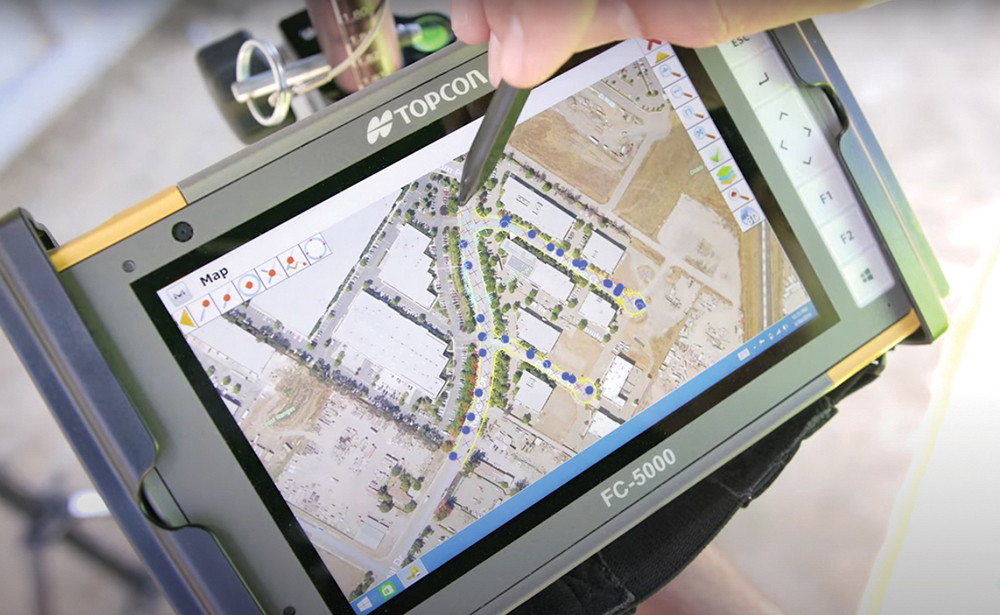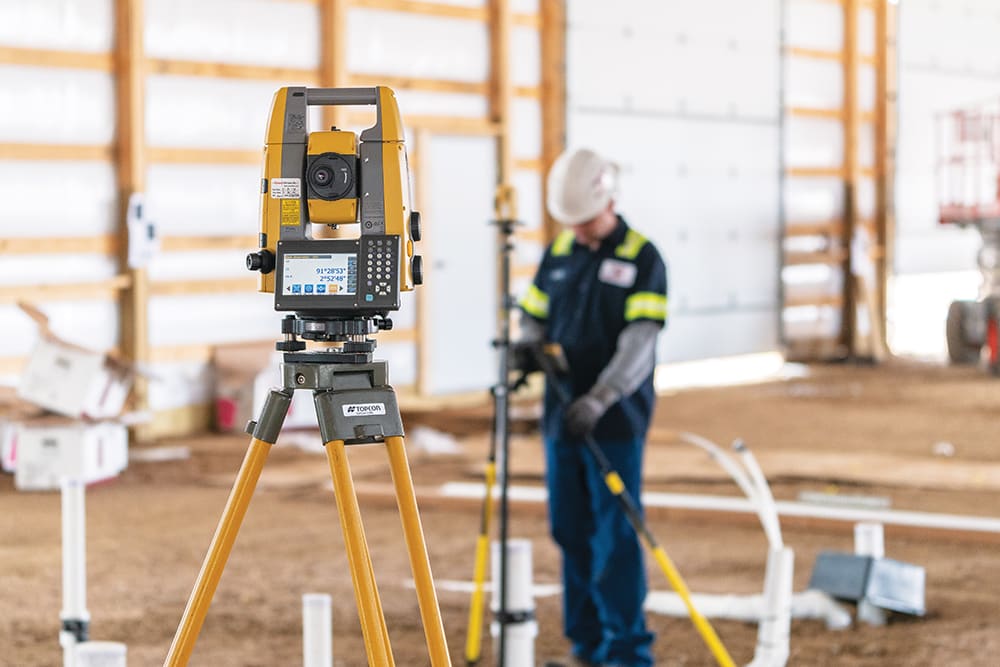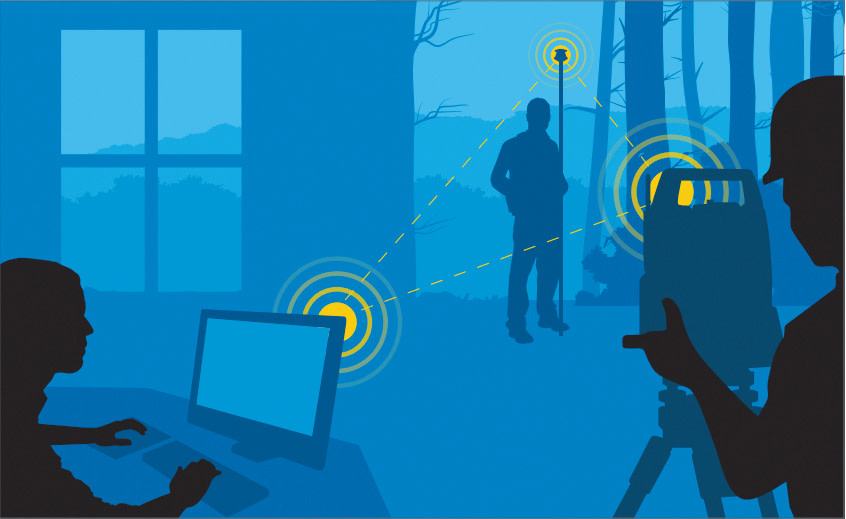Robotic total stations have helped revolutionise surveying in the construction industry, saving time and money and increasing productivity. But how do they actually work and what does the future hold for this type of technology?
A total station is an electronic, optical instrument that is used in surveying and building construction. Combining an electronic theodolite with electronic distance measurement (EDM), the technology allows for the measurement of both vertical and horizontal angles and the distance from the instrument to a particular point. Traditionally a manual instrument, robotics have revolutionised the tool, making it more efficient than ever.
The history of surveying
Before the construction industry had even begun to dream of this technology, the origins of land surveying can be traced back to at least 1400BC in ancient Egypt. During this period, Egyptians used various instruments including rope and plumb bobs to manually survey plots of land for building projects such as the pyramids and land taxation.
Fast forward to the early 19th century and with the Industrial Revolution in Europe came the official recognition of surveying as a profession. At this point in time, with the development of new roads, buildings and railways, the role of land surveying became more important than ever for the smooth development of infrastructure.
During this period, the plane table survey was frequently used to perform land surveys. Using a plane table, tripod and alidade (sighting device), the method involved fixing the plane table on to a tripod in the necessary position in the field, placing a sheet of paper on top for drawing and using the ruler-like alidade to sight distant objects, determine directions and measure angles.
The surveyor would then draw the plans, using the alidade to find measure-ments and angles, moving the plane table around the field when necessary.
The plane table method enabled surveyors to draw plans while observing the area that needed to be surveyed – meaning that field observations and plotting could be done simultaneously. Comparing the plotted work with the actual field, the method offered a simple and cheap way of surveying.
However, the method had many limitations that led to it being replaced as technology advanced. For example, the method was not appropriate for use in harsh weather conditions and many other accessories were also required to improve accuracy, such as compasses. The plane itself was also heavy, meaning it was inconvenient to transport to different sites.
Finally, the potential for human and instrumental error while plotting and drawing did not allow for very accurate work and, as a result, the method was later replaced by the use of the theodolite.
Consisting of a movable telescope, a theodolite is a precision optical instrument whose telescope rotates around horizontal and vertical axes to provide angle measurements. Originally a non-digital piece of equipment, theodolites were upgraded to become electronic, with their non-electric counterparts now rarely in use.
As the technology has developed, electronic theodolites have been incorporated with EDMs to become the modern-day total station.
What is a robotic total station?
Simply put, a robotic total station is a total station that can be operated remotely from a distance, meaning that only one operator is needed in the field rather than the traditional two-person team of surveyor and assistant.
While previously site workers had to physically turn total stations vertically and horizontally to sight them to the positions to observe or set out, through automation robotic total stations follow human lead by tracking a prism held by the surveyor at the pole end.

Above: A Topcon LN-150 layout navigator in use on site

Information can be accessed on site via Topcon’s FC-5000 handheld field computer
The instrument constantly transmits the angle and distance information measured to the prism on to the data logger, also at the pole end with the surveyor, via developments like Topcon’s LongLink Bluetooth tech-nology. This enables them to take measurements for surveys and set out points, lines and surfaces without having to return to the instrument.
Motor technology is the driving force behind robotic total stations, making sure the instrument moves without human touch. Topcon’s GT Series uses some of the fastest ultrasonic motors available. At 180 degrees per second, these offer smooth and accurate prism-tracking.
The instruments are also one-third smaller in size than others, making them a compact and high-performance solution in providing long-range operation and reflectorless measurements – perfect for surveying and construction needs.
As a single-operator robotic system, robotic total stations reduce the cost of having an additional person on site, improving efficiencies and related costs by freeing up team members who would have otherwise been on site, allowing them to perform other tasks elsewhere.
The instrument’s increased accuracy also means that there are fewer errors, reducing the need for rework and the cost of time and resource associated with this. Additionally, improved accuracy reduces the cost of wastage.
Increased productivity
Since professionals don’t have to manually turn the instrument to collect or set out a point, robotic total stations save time on the process of surveying and setting out — increasing onsite productivity.
Some workflows, for example as-built survey projects for concrete slab levels, can comfortably see a 50% increase in productivity. This is because, where previously professionals used an auto level for observations and then manually plotted the points and calculated heights to produce an as-built drawing, robotic total stations can shoot to the prism and calculate coordinate values and heights for those points almost instantly.
This data is collected and saved to the data logger and can then be exported into a CAD-based software package like MAGNET Office Survey to produce digital drawings for as-builts that show deviations in height.

A single operator can work on site with Topcon’s GT Series total stations
Furthermore, the instrument can be used to confirm the verticality of walls and columns by taking reflector-less measurements for the top and bottom of walls and columns using codes to differentiate between the measurements. This data is again taken into a CAD package, such as MAGNET Office Survey, to compare the surveyed data against design drawings, giving deviations and producing as-built drawings almost instantly.
The positional information relayed from the instrument via Bluetooth technology, like Topcon’s LongLink, to the data logger also speeds up the setting-out process as it means the professional at the pole end with the logger already has the information available to them.
Through the use of software like Topcon’s MAGNET Field, construction professionals are able to import and display a digital drawing, such as a DXF/DWG, or a model, such as an IFC format of the project, on the screen of the logger. As a result, they can work directly from the drawings or the model depending on the information available to them on site.
This process is also more time and cost efficient as it eliminates the need for a surveying/engineering assistant on site and negates the need to have people manually inputting data for setting out into the instrument or data logger, which in turn reduces the capacity for further errors on site.
When on site, the person controlling the instrument is comfortable in the knowledge that the robotic total station is accurately measuring the data, and sending it to the data logger for them to collect a point or set out a position that they are happy with. Professionals are then all working from the same drawing, reducing mistakes and discrepancies in the overall process.
With easy-to-use CAD-based software like Topcon’s MAGNET Office Survey, time is also being saved when pulling reports together. Whereas reporting traditionally could take hours, this technology is allowing companies to pull together as-built reports in just 15 minutes, again increasing overall workflow productivity.
The future of robotic total stations
As more construction and surveying professionals have begun to recognise the value that robotic total stations have on productivity, they have become commonplace on sites.
The future of the instrument has also arrived in the form of Topcon’s GTL-1000. Featuring a robotic total station, the equipment includes a scanner to allow construction professionals to scan and verify in addition to carrying out traditional robotic total station functions.

Robotic total stations can survey, scan and analyse data within hours
Operating as a fully functional robotic total station and a high-speed, high-quality laser scanner means that, with a few clicks and few minutes of time, the GTL-1000 can produce a complete, 360-degree, locally registered point cloud of an area. As a result, the time taken for data capture and processing is sped up, saving a significant amount of time.
There are not only short-term, but long-term time savings too. Using the GTL-1000 along with Verity software, it is easy to identify potential issues long before errors incur onsite costs.
For construction professionals this is extremely beneficial, as finding out something may have been installed incorrectly early in the construction process eliminates the extra costs of time and resources. This can also avoid any negative reputational impacts that mistakes and additional work may bring.
Without the GTL-1000, scanning and analysing data can take days. However, with the technology, the process can be done in a matter of hours. An engineer can go out to the field in the morning to scan the latest installed elements, analyse the scan data and then be back on site before lunch with a list of changes that may have been identified. In the past, this was not possible because of the time taken to complete the scanning and analysing process.
The practicality of having just one instrument should also not be underestimated. Usually, to register scan data, engineers would require a robotic or manual total station to coordinate scan targets, with these then scanned with the laser scanner then identified within a processing software package to register the point cloud.
However, with a combined unit such as the GTL-1000, engineers no longer need to set up two different instruments in the same location. Instead, it can all be done in one swift movement, potentially halving the amount of time spent on site.
A combined unit is also more cost-effective than having two separate instruments, with the price of purchasing two pieces of equipment often amounting to up to 50% more than buying a single instrument.
Although there are different technology combinations available on the market which may be cheaper, the overall cost savings for projects have still proved significant when a combined device is used.
Despite the powerful technology the GTL-1000 contains, the device weighs only 7kg and fits into one case. As a result, it is easy to carry around site, transport, set up and operate. This ease of transportation acts as a time-saver as energy is not wasted stopping and starting when carrying heavy materials. Instead, professionals can swiftly set up once they have arrived on site.
Investing in technology
The surveying profession has come a long way since its origins in ancient Egypt, with technology and digitalisation allowing the industry to continually improve its accuracy, efficiency and speed.
The future looks bright, with many more professionals recognising the benefits that robotic total stations bring. Businesses investing in this technology are saving time, money and resources thanks to innovations like the GTL-1000, which are capable of much more than the average total station.
This article has been produced in association with Topcon.

Don’t miss out on BIM and digital construction news: sign up to receive the BIMplus newsletter.
Comments
Comments are closed.












Price for the GTL-1000 with Verity software. What is the combined option please.
the Engineer had a junior assistant for thousands of years…… until now… quantity surveyors have removed the chainboy/junior engineer role completely from the industry now because of this…. sad times….. not good… oh well lets get an assistant qs now